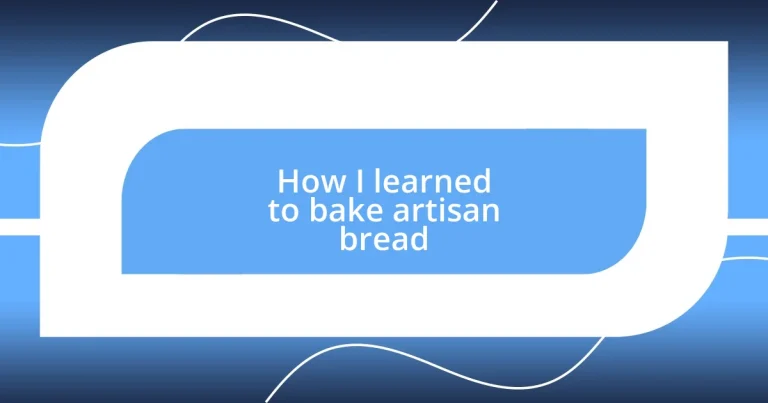Key takeaways:
- Understanding fermentation and using the right ingredients, especially high-protein bread flour, enhances the flavor and texture of artisan bread.
- Using proper tools, like a sharp bread knife, Dutch oven, and digital kitchen scale, significantly improves the baking process and outcomes.
- Techniques such as autolyse, temperature control, and ensuring proper rising times are essential for creating perfect dough and avoiding common baking issues.
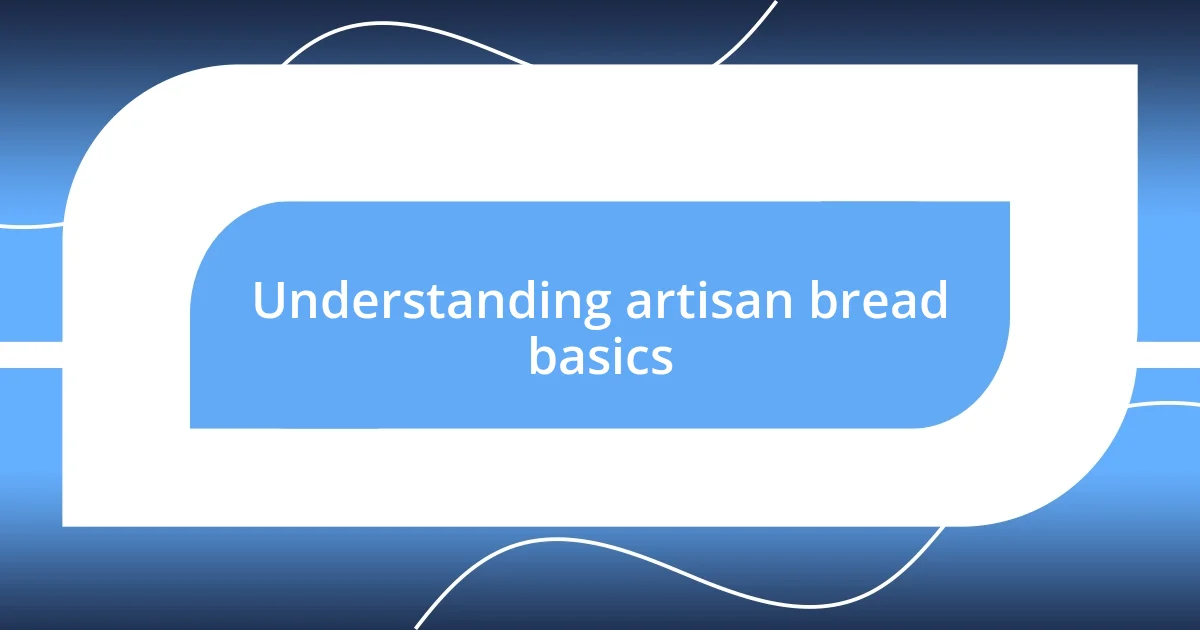
Understanding artisan bread basics
Artisan bread is more than just a loaf; it’s a craft rooted in tradition. When I first delved into baking, I was captivated by how simple ingredients – flour, water, salt, and yeast – could transform into something so exquisite. Have you ever watched dough rise and bubble? It’s like witnessing magic unfold right in your kitchen.
Understanding the importance of fermentation was a game changer for me. That slow process allows for the development of complex flavors and a chewy texture that’s hard to replicate with quick methods. I remember the first time I tasted my homemade sourdough—it had this deep, tangy flavor that store-bought bread simply couldn’t match. Isn’t it rewarding to savor a slice of bread that you put your heart into?
Moreover, the technique of hand-kneading versus using a mixer can greatly influence the final result. Feeling the dough transform under my hands felt so therapeutic, almost like a conversation between me and my ingredients. It’s fascinating how by merely adjusting kneading time or resting periods, you can impact everything from crust texture to crumb structure. Isn’t it a beautiful reminder of how slight nuances can lead to different outcomes in both baking and life?
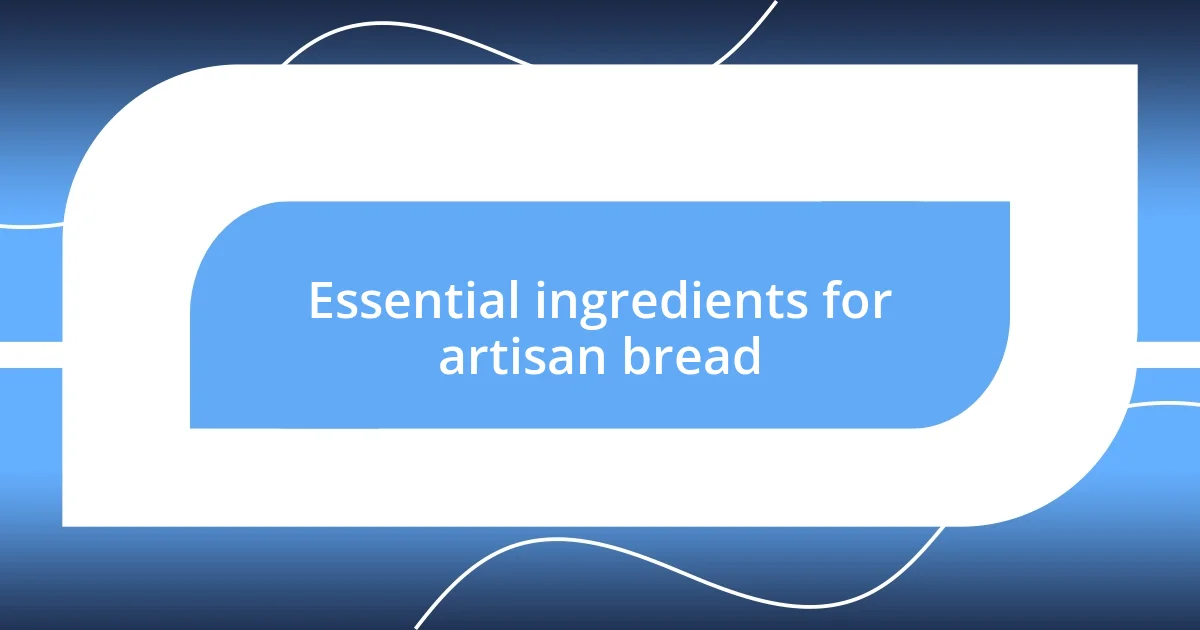
Essential ingredients for artisan bread
One of the most essential ingredients when it comes to artisan bread is flour. I discovered that not all flours are created equal; the type I chose had a huge impact on the texture and flavor. Initially, I started with all-purpose flour, but as I experimented, I fell in love with using bread flour. Its higher protein content gave my loaves a strong structure and that satisfying chew. It felt empowering to watch my dough become more elastic with every fold.
Here’s a quick overview of the essential ingredients for artisan bread:
- Flour: Preferably bread flour for better structure.
- Water: Essential for hydration and enabling gluten development.
- Salt: Enhances flavor and controls yeast fermentation.
- Yeast: Either instant or active dry yeast, depending on your preference.
- Optional add-ins: Ingredients like honey or olive oil can enrich flavor and texture.
Remember, each ingredient plays a role in the final loaf. When I first added a bit of olive oil to my dough, I was surprised at how it created a softer crumb. Little modifications can lead to delightful discoveries; that’s part of the beauty of baking artisan bread.
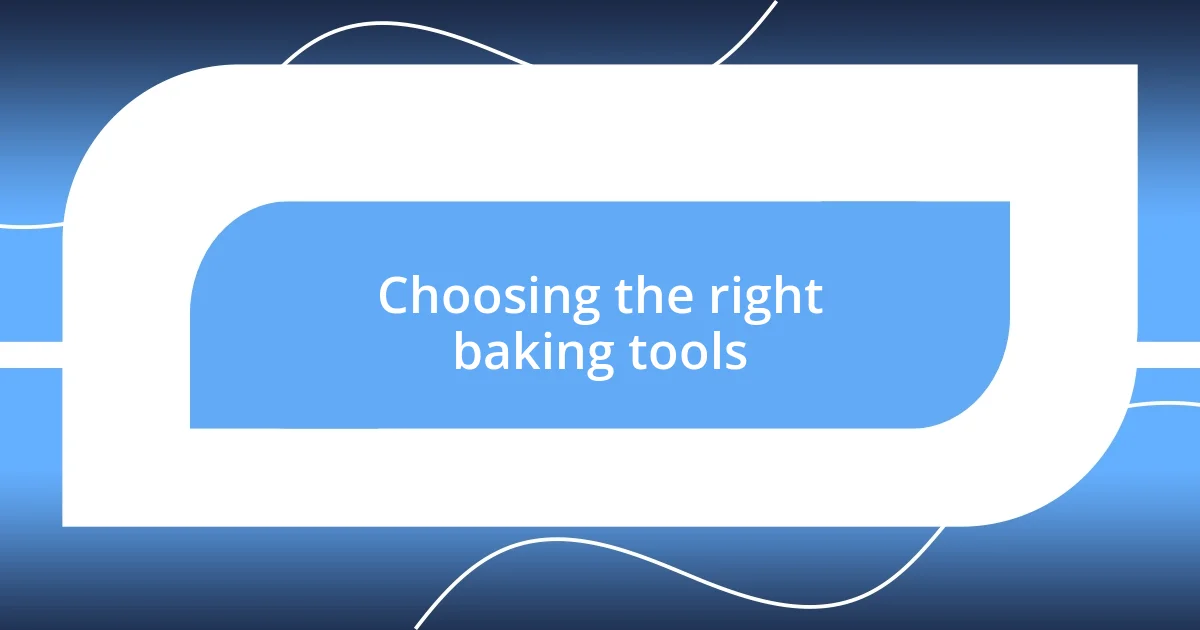
Choosing the right baking tools
Choosing the right baking tools can truly elevate your artisan bread-making experience. When I first started out, I relied on basic kitchen utensils, but I soon realized that specific tools could make a world of difference. A good bread knife is essential; I vividly remember my initial struggle, using a dull knife that squished my beautiful sourdough instead of slicing through it cleanly. Investing in a sharp, serrated knife not only improved my loaves’ presentation but also added to my pride every time I served a perfect slice.
In addition to a quality knife, a Dutch oven became one of my favorite baking tools. The first time I baked a loaf in it, the bread rose beautifully and developed the ideal crust. The enclosed space of the Dutch oven traps steam, which is crucial for that artisanal finish. I felt like a professional baker when I pulled that golden loaf out of the oven. It’s a fantastic tool that anyone serious about bread baking should consider having in their kitchen.
Lastly, a digital kitchen scale can help ensure precision in your measurements. I was amazed at how much my results improved when I started weighing my ingredients instead of using measuring cups. There’s something incredibly satisfying about getting everything just right. I remember baking a loaf that turned out perfectly airy and light because I was meticulous about my measurements. It’s all about consistency, and that scale became my trusty sidekick in my baking adventures.
| Tool | Purpose & Benefit |
|---|---|
| Bread Knife | Ensures clean slices without squishing the loaf. |
| Dutch Oven | Creates steam for a crispy crust and excellent rise. |
| Digital Kitchen Scale | Provides precise measurements for consistent results. |
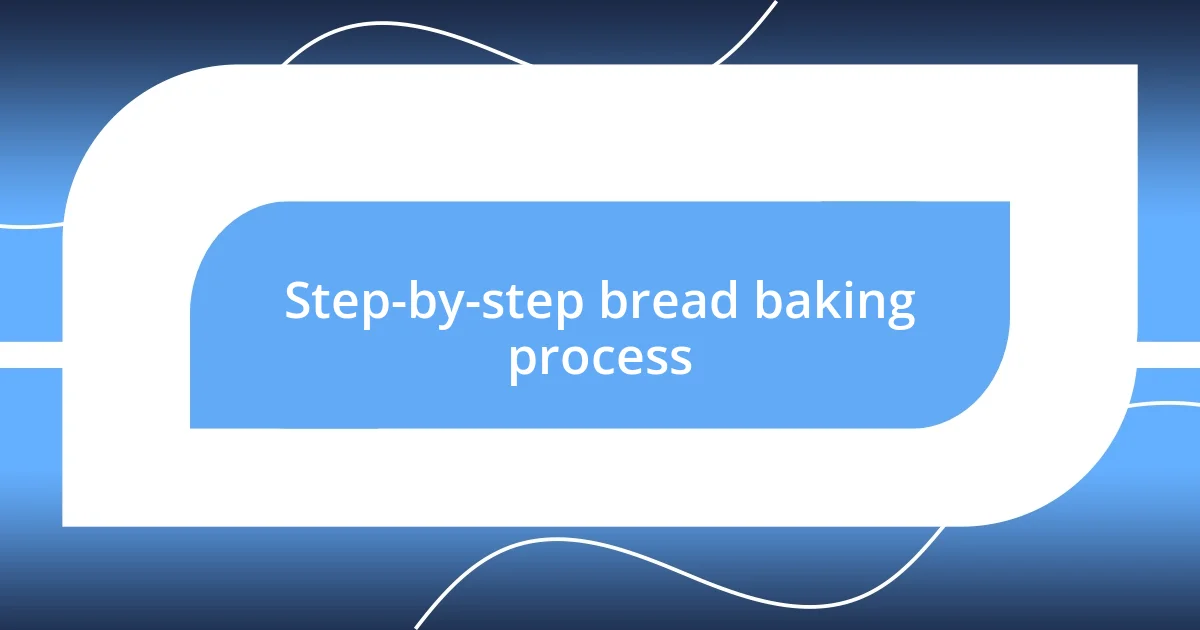
Step-by-step bread baking process
Once you’ve gathered your ingredients and tools, the next step is mixing the dough. I remember the first time I combined flour, water, and yeast; it felt like magic as the ingredients transformed into a sticky, cohesive mass. It’s amazing how just a few simple ingredients can create something so satisfying! I initially used a wooden spoon, but I quickly learned that using my hands was the best way to knead and really connect with the dough, feeling its texture change under my fingertips.
After mixing, the dough needs time to rise. I was surprised how important this step is; it’s not just a waiting game, but rather a crucial phase where the yeast works its magic. I once mistakenly shortened the rising time and ended up with dense bread, which I later dubbed my “rock loaf.” Trust me, allowing the dough to double in size is essential, and I found it delightful to watch that transformation happen!
Now comes the shaping and second rising. I recall my first attempts at shaping my dough into a round loaf; it was a messy yet rewarding process. The moment I flipped the dough onto a floured surface and folded it into itself, I felt a sense of accomplishment. This stage is when you can really let your creativity shine. What I learned is that being gentle yet firm is key. After shaping, I let my dough rise again, and I’d often find myself peeking under the cloth, feeling like a child on Christmas morning, eager to see if my efforts resulted in a beautiful, puffy loaf!
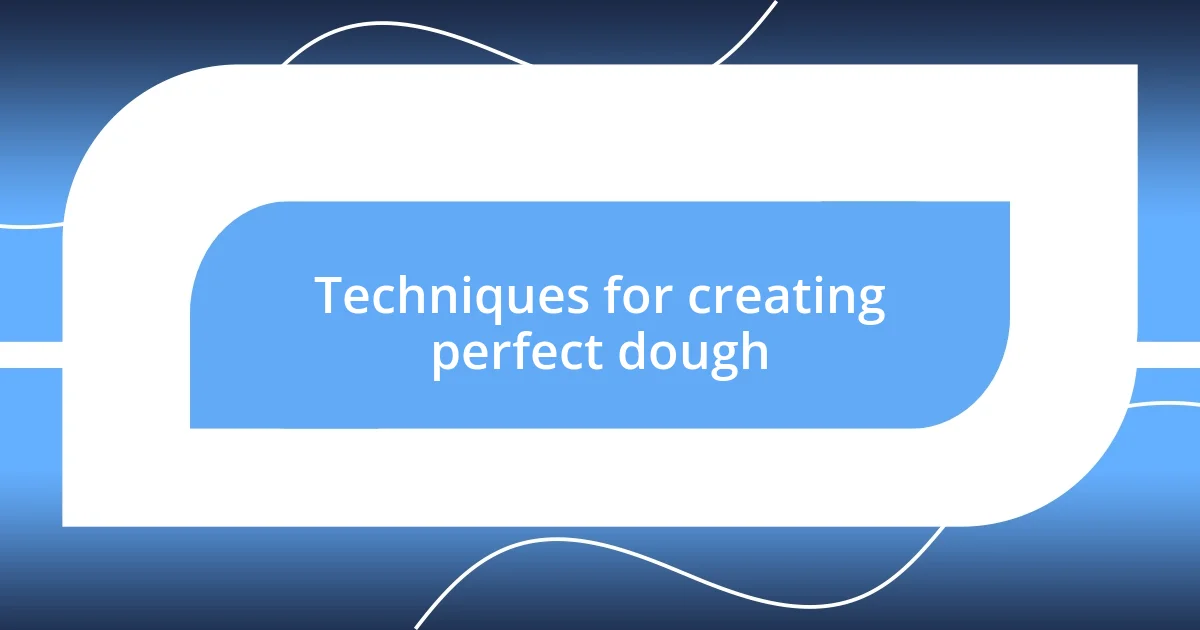
Techniques for creating perfect dough
When it comes to creating perfect dough, one of the most significant techniques I’ve adopted is the autolyse method. It’s simple yet powerful: just mix your flour and water and let it rest for about 30 minutes before adding yeast and salt. This technique allows the flour to fully hydrate, leading to a more extensible dough. I remember the first time I tried it; the dough felt noticeably softer and more elastic when I went to knead it. It was like discovering a secret shortcut to better bread!
Another key technique is to practice the slap-and-fold method during kneading. At first, it felt a bit awkward, almost like I was wrestling with the dough! But over time, I learned to really engage with it — the rhythm of slapping and folding not only strengthens the gluten but also gives me a tactile understanding of the dough’s development. I still smile when I think about the satisfaction that washed over me the first time I felt that perfect smooth texture under my hands. It truly transforms the experience from mere mixing to an art form.
Lastly, temperature control plays a crucial role in creating dough. I’ve experimented with various temperatures, and I noticed that warmer dough rises faster but risks over-proofing. On one occasion, my excitement got the best of me, and I left a batch to rise in a warm spot for too long. The collapse of my dough was heartbreaking! Now, I swear by using a simple thermometer to keep tabs on both the dough and the environment. Finding that sweet spot where the dough rises beautifully has become almost a meditative practice for me, enriching my baking journey in ways I never expected.
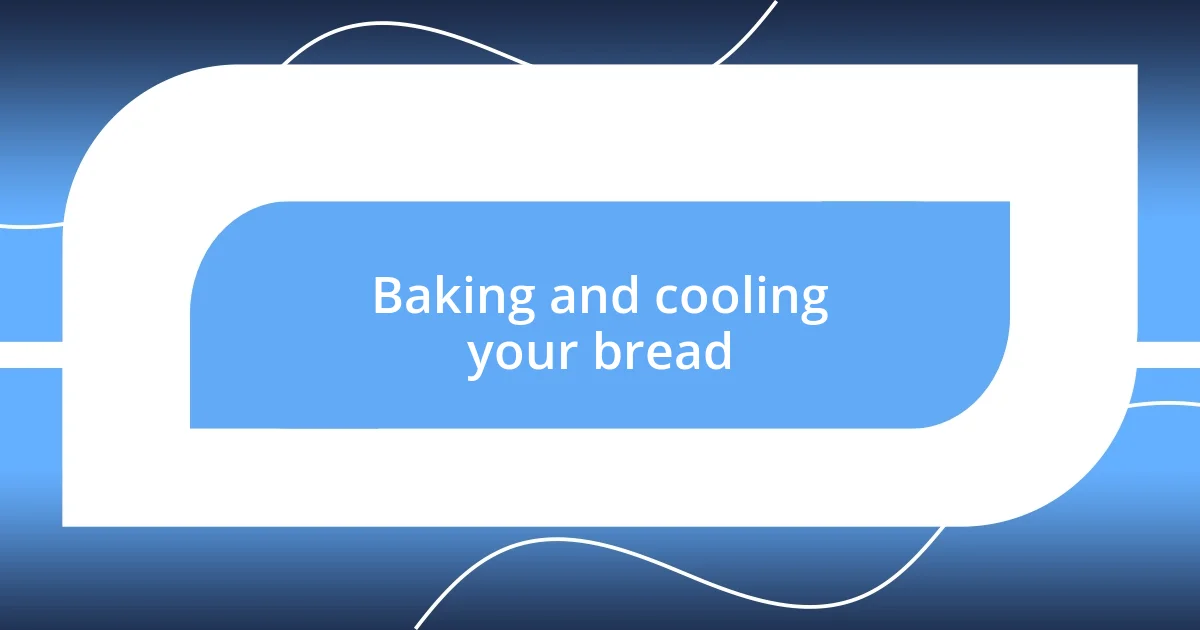
Baking and cooling your bread
After shaping your dough, the next exciting step is baking it. I remember the first time I slid a loaf into the oven; my heart raced with anticipation. Hearing that glorious sizzle as the bread hit the hot surface was like music to my ears. It’s crucial to preheat your oven well, as that beautiful crust we all love begins to form immediately. Sometimes, I add a shallow pan with water beneath the loaf to create steam, and let me tell you, the difference is remarkable! That nice, crunchy crust is worth every little effort.
Once your bread is baking, the aromas that waft through the kitchen are absolutely intoxicating. I still smile thinking about the time my neighbor knocked on my door, completely drawn in by the smell. It’s a beautiful moment, right? However, I also learned the hard way that patience is essential. Overbaking even by a few minutes can transform that delightful loaf into a dry disappointment. So, I’ve made it a habit to set a timer and check my bread a little early; it’s become an automatic part of my baking ritual.
Cooling the bread properly is just as important as baking it. I’ll never forget the first loaf I sliced too soon — the steam escaped, and the texture suffered. Now, I let my bread rest on a wire rack for at least an hour. This allows the interior to finish setting up and develops those soft textures we crave. Plus, it gives me just enough time to enjoy the moment, perhaps with a nice cup of tea. So, the next time you pop a loaf out of the oven, remember: patience is a baker’s best friend!
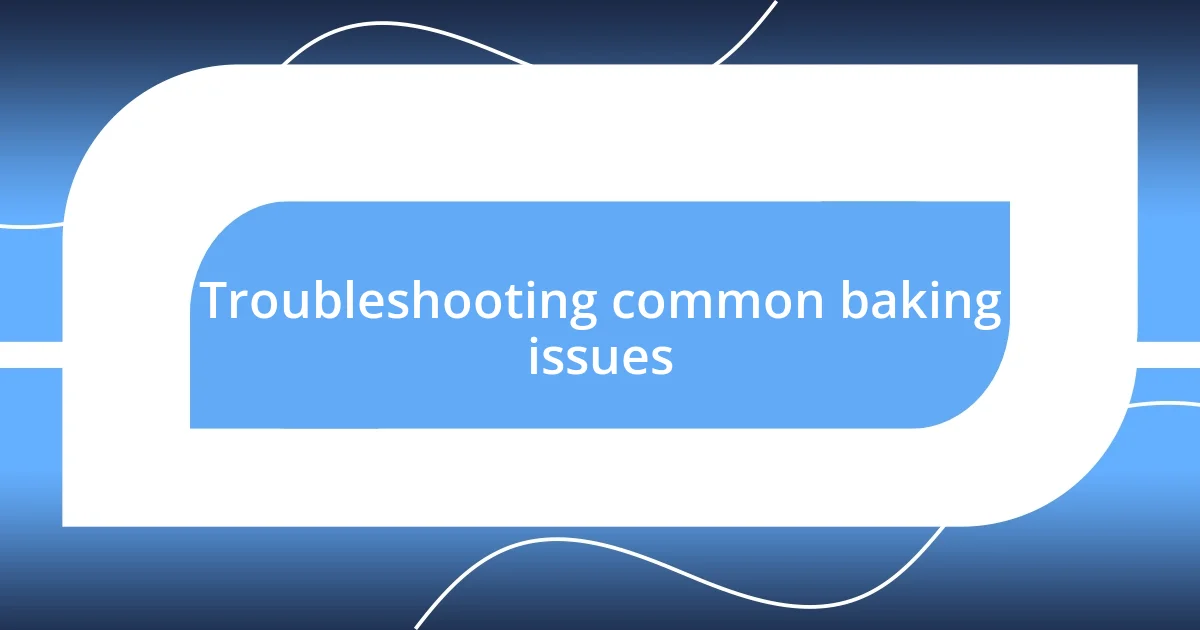
Troubleshooting common baking issues
When tackling common baking issues, I often remind myself that every mishap can be a learning opportunity. For example, I once experienced a flat loaf that barely rose, and I later discovered it was due to stale yeast. That moment was disappointing, but it taught me the importance of checking those expiration dates. Have you ever faced a similar issue?
Another common problem is a tough crust. I fondly recall a time I pulled out a loaf that looked stunning but felt like a brick when I tried to slice it. The culprit? Baking it without enough steam. Since then, I’ve made it a habit to add water to the oven or use a covered Dutch oven, which really makes a difference. It’s amazing how simple adjustments can elevate your bread from a struggle to something truly enjoyable!
Lastly, let’s address that dreaded gummy interior. The first time this happened to me, I felt a mix of frustration and confusion. I learned that underbaking was often to blame. Now, I trust my instincts alongside my timer. I take the bread’s temperature with an instant-read thermometer—it should reach about 190°F for a perfect bake. This little extra step has become vital in my baking routine, ensuring I avoid that gummy disappointment that can really bring down your hard work. Have you found any little tricks that save you from these common pitfalls?












